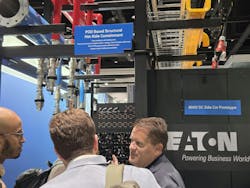Preparing for 800 VDC Data Centers: ABB, Eaton Support NVIDIA’s AI Infrastructure Evolution
Key Highlights
- ABB and NVIDIA are collaborating to develop 800V DC power solutions supporting 1-MW racks, enabling more efficient and scalable AI data centers.
- The partnership aims to produce reference designs, modular power blocks, and integrated protection schemes aligned with industry standards and ecosystem needs.
- Transitioning to 800V DC reduces conversion losses, space requirements, and copper use, facilitating higher-density, liquid-cooled AI racks.
- Industry momentum is growing, with vendors like Eaton also unveiling 800V DC reference architectures, signaling a shift toward gigawatt-scale AI infrastructure.
- This initiative positions the electrical architecture as a key enabler of AI scalability, bridging the gap between compute demands and power delivery at gigawatt levels.
ABB and NVIDIA have announced a collaboration to accelerate the development of gigawatt-scale, next-generation data centers, focusing on the power architecture required to support 1-megawatt racks and multi-gigawatt campuses. Under the agreement, ABB will help develop and industrialize high-efficiency, 800-volt DC power solutions, marking a major architectural leap beyond today’s AC-based ecosystems.
As AI workloads expand at an exponential pace, NVIDIA’s roadmap — beginning with the Vera Rubin NVL144 and extending to future MGX modular systems—signals a decisive move toward denser, liquid-cooled “AI factories.” These designs push for higher liquid temperatures, liquid-cooled busbars, and larger rack-level energy storage to stabilize power delivery and thermal balance.
In short, power has become the defining bottleneck within modern data centers. NVIDIA has stated plainly that supporting 1 MW-plus IT racks will require a shift to 800 V DC distribution by around 2027, cutting conversion stages, conductor mass, and resistive (I²R) losses. Achieving this transformation will require a full ecosystem—from substations and MV/LV distribution to UPS systems, switchgear, protection, and controls—precisely the domains in which ABB has concentrated its latest development efforts.
As pointe out by Giampiero Frisio, President, ABB Electrification:
ABB is leading the development of the key new power distribution technologies that will create the next generation of data centers. We have been an early investor in the cutting-edge UPS, DC and solid-state electronics that will enable data centers to stay ahead of AI’s growing power demands. Through our collaboration, NVIDIA and ABB are supporting the industry in advancing toward 800 volt architectures that will enable the high-density AI infrastructure needed to fuel the next generation of AI.
Vendors and operators are already preparing for AI campuses measured in gigawatts. ABB’s announcement underscores the scale of this transition—not incremental retrofits, but entirely new development models for multi-GW AI infrastructure.
How ABB Is Supporting the Move to 800-V DC Data Centers
ABB says its joint work with NVIDIA will focus on advanced power solutions to enable 800-V DC architectures supporting 1-MW racks. Expect DC-rated breakers, protection relays, busways, and power shelves engineered for higher DC voltages, along with interfaces for liquid-cooled rack busbars.
In parallel with the NVIDIA partnership, ABB has introduced an AI-ready refresh of its MNS® low-voltage switchgear, integrating SACE Emax 3 breakers with enhanced sensing and analytics to reduce footprint while improving selectivity and uptime. These components form the foundational building blocks of the higher-density electrical rooms and prefabricated skids that will define next-generation data centers.
ABB’s MegaFlex UPS line already targets hyperscale and colocation environments with megawatt-class modules (UL 415/480-V variants), delivering high double-conversion efficiency and seamless integration with ABB’s Ability™ Data Center Automation platform—unifying BMS, EPMS, and DCIM functions. As racks transition to 800-V DC and liquid-cooled buses, continuous thermal-electrical co-optimization becomes essential. In this new paradigm, telemetry and controls will matter as much as copper and coolant.
NVIDIA’s technical brief positions 800-V DC as the remedy for today’s inefficiencies—reducing space, cable mass, and conversion losses that accompany rising rack densities of 200 to 600 kW and beyond. The company’s 800-V rollout is targeted for 2027, with ecosystem partners spanning the entire electrical stack. Early signals from the OCP Global Summit 2025 confirm that vendors are moving rapidly to align their products and architectures with this vision.
The Demands of Next-Generation GPUs
NVIDIA’s Vera Rubin NVL144 rack design previews what the next phase of AI infrastructure will require: 45 °C liquid cooling, liquid-cooled busbars, and 20× more rack-level energy storage to stabilize power. This close coupling between the compute stack and the powertrain is exactly what ABB aims to engineer at facility scale.
The evolutionary path is clear: today’s GB200 NVL72 racks are already appearing in partner datasheets; the next-generation NVL144 and NVL576 systems will push density dramatically higher, driving facilities toward high-voltage DC distribution and integrated liquid power buses. Hardware activity around the OCP Global Summit 2025 reflects how ecosystem partners are rapidly iterating to meet this vision.
Rethinking the Power Chain from Grid to Rack
The shift to 800-V DC requires re-examining every layer of the electrical chain—from the grid interconnect down to the rack. Key benefits include:
-
Higher efficiency: Fewer conversion stages and reduced I²R losses at higher voltages, cited by NVIDIA as a primary driver for 1-MW racks.
-
Smaller electrical rooms: Less copper, fewer PSUs, and more compact LV gear—ABB’s refreshed MNS/Emax 3 platform directly supports this footprint reduction.
-
Thermal-power co-design: Rack-level liquid-cooled busbars and higher-temperature liquid loops improve exergy and enable heat reuse but require tight synchronization between electrical and thermal controls. NVIDIA’s specifications highlight 45 °C coolant and integrated energy storage—areas where ABB’s automation stack provides a natural interface.
Toward Modular, Factory-Integrated Power Blocks
Guidance from OCP 2025 and ongoing ecosystem discussions point toward prefabricated skids and pods that combine rectification, protection, energy storage, and CDUs as factory-integrated blocks. Vendors with experience in modular platforms will have a clear advantage as companies such as ABB and its competitors begin to productize pre-configured power modules as scalable building blocks for 800-V DC data centers.
What Else the ABB–NVIDIA Partnership Will Bring
Reference Designs and Ecosystem Integration
ABB expects to publish reference designs and product SKUs aligned with NVIDIA’s MGX and NVL rack families. Look for named reference architectures—including MV-to-800-V DC power blocks, DC protection schemes, liquid-cooled busways, and integration handbooks—developed through joint R&D initiatives to “develop and deploy cutting-edge power solutions” for NVIDIA’s 800-V era.
Advancing Standards and Protection Schemes
Expect major progress around DC protection coordination, including fault detection, arc-flash mitigation, and selectivity for 800-V DC operation. ABB’s SACE/Emax digital switchgear lineage positions it to become a template for 800-V DC selectivity curves and event forensics, giving the industry a starting point for consistent protection frameworks.
Thermal–Electrical Convergence
As NVIDIA’s racks adopt liquid-cooled busbars and higher liquid setpoints, facilities teams will need to co-optimize cooling-distribution units (CDUs), secondary loops, and electrical transients. ABB is expected to package coordinated control systems linking rack-level energy storage, UPS behavior, and CDU setpoints, allowing AI clusters to ride through micro-sags or switching events without throttling GPUs.
Industry Momentum Around 800-V DC
The broader ecosystem is rallying behind this voltage class. **Component vendors—spanning power semiconductors, PSUs, and busbar manufacturers—**are unveiling OCP 2025 prototypes and white papers focused squarely on 800-V HVDC for AI infrastructure. Across OCP updates and vendor releases, the message is consistent: 1-MW racks are no longer hypothetical—they are the design baseline for the AI era.
What This Means for the Industry
NVIDIA’s move to 800-V DC distribution marks the clearest signal yet that AI data centers are being redesigned around power first. The electrical architecture is no longer a supporting system—it’s the defining constraint and enabler of scale.
By partnering with ABB, NVIDIA gains a proven industrial collaborator to productize the full electrical and controls stack—from protection and switchgear to UPS, automation, and modular integration. This partnership bridges the gap between AI system design and the physical power infrastructure required to realize it at gigawatt scale.
Over the next two years, expect to see reference designs, prefabricated power blocks, and DC-ready switchgear and UPS platforms roll out in concert with NVIDIA’s NVL and MGX rack families, setting the stage for 2027-era 800-V deployments and the broader industrialization of AI factory design.
The Ecosystem Widens: Eaton Joins the 800 VDC Vanguard
Industry momentum around 800 VDC power architectures accelerated further at the OCP Global Summit 2025, where Eaton unveiled its next-generation reference architecture for AI factories. The design—developed in collaboration with NVIDIA—marks a milestone in Eaton’s “grid-to-chip” strategy and underscores the company’s leadership role within the Open Compute Project.
Eaton’s JP Buzzell, Vice President and Data Center Chief Architect, serves as co-chair of OCP’s Power Distribution Sub-Project alongside ABB’s Paolo Catapane, guiding the community’s technical roadmap for 800-V DC and low-voltage direct-current (LVDC) design standards.
Eaton’s new 800 VDC reference design integrates the company’s advanced power-management portfolio—supercapacitor-based ride-through storage, ORV3-compatible busbar distribution, DC connectors, and hot-aisle containment systems—to protect and optimize megawatt-scale AI racks. The architecture directly supports NVIDIA’s 800-V roadmap and exemplifies how the grid-to-rack power chain is being rebuilt for the AI industrial era.
“The introduction of 800 VDC architectures is a transformative advancement for data center innovation that will enable new possibilities in AI computing,” said Buzzell. “This new reference design represents a major step in our grid-to-chip strategy, helping accelerate the transition to the AI factory of the future.”
At the OCP Summit, Eaton’s and ABB’s shared leadership was obvious. Together, their teams are defining LVDC (≤ 1500 V) frameworks covering protection coordination, backward compatibility, and safety to ensure interoperability across next-generation systems. Deliverables include a Q1 2026 white paper detailing the business case, architecture, and component specifications for large-scale LVDC adoption.
ABB and Eaton are now anchoring the standards, components, and control logic that will guide the industry’s shift from AC to DC distribution inside data centers. Their dual collaborations with NVIDIA point to a shared outcome: the AI factory of 2027 will be defined as much by power-engineering discipline as by compute innovation.
At Data Center Frontier, we talk the industry talk and walk the industry walk. In that spirit, DCF Staff members may occasionally use AI tools to assist with content. Elements of this article were created with help from OpenAI's GPT5.
Keep pace with the fast-moving world of data centers and cloud computing by connecting with Data Center Frontier on LinkedIn, following us on X/Twitter and Facebook, as well as on BlueSky, and signing up for our weekly newsletters using the form below.
About the Author

David Chernicoff
Matt Vincent
A B2B technology journalist and editor with more than two decades of experience, Matt Vincent is Editor in Chief of Data Center Frontier.



